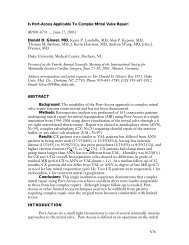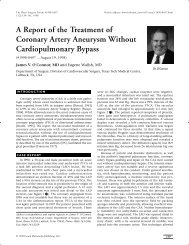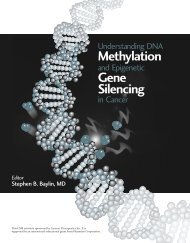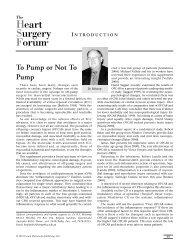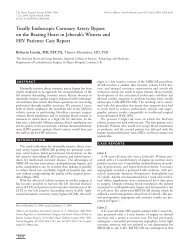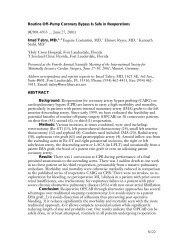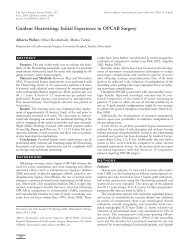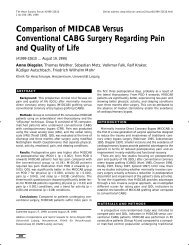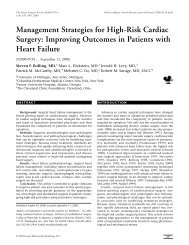Multiple Myeloma: A Practical Guide to Current Management
Multiple Myeloma: A Practical Guide to Current Management
Multiple Myeloma: A Practical Guide to Current Management
You also want an ePaper? Increase the reach of your titles
YUMPU automatically turns print PDFs into web optimized ePapers that Google loves.
<strong>Multiple</strong> <strong>Myeloma</strong>: A <strong>Practical</strong> <strong>Guide</strong> <strong>to</strong><br />
<strong>Current</strong> <strong>Management</strong><br />
POSTTRANSPLANTATION MAINTENANCE<br />
12<br />
Is posttransplantation maintenance therapy of value<br />
in multiple myeloma?<br />
There were divergent opinions on maintenance therapy<br />
for patients with multiple myeloma. Therapy in this<br />
setting is being actively investigated, and the panel did not<br />
arrive at any consensus regarding the agent(s) of choice<br />
in this setting. In one study [Berenson 2002], alternateday<br />
oral prednisone was evaluated at two dose levels (10<br />
mg or 50 mg) in 250 patients with previously untreated<br />
multiple myeloma following induction chemotherapy<br />
with the VAD regimen. Although treatment-related<br />
adverse events were similar in patients receiving either<br />
10 or 50 mg alternate-day prednisone, the 50-mg dose was<br />
associated with significantly longer progression-free<br />
survival compared <strong>to</strong> the 10 mg dose (14 months vs. 5<br />
months p=0.003) and median survival (37 months vs.<br />
26 months p=0.05).<br />
The National Cancer Institute of Canada (NCIC):MY-9<br />
was a multi-center, randomized phase II trial that<br />
evaluated the <strong>to</strong>lerability of combined thalidomide and<br />
prednisone maintenance in multiple myeloma [Stewart<br />
2004]. Patients were eligible if they had received<br />
melphalan 200 mg/m 2 with au<strong>to</strong>logous stem cell<br />
transplants within one year of treatment onset.<br />
Maintenance therapy was initiated within 60 <strong>to</strong> 100 days<br />
after stem cell transplantation. In the maintenance arms<br />
of the trial, patients were randomized <strong>to</strong> receive<br />
prednisone 50 mg/day on alternate days and thalidomide<br />
at a dose of either 200 mg/day or 400 mg/day. Therapy<br />
discontinuation or <strong>to</strong>xicity-associated dose reductions in<br />
thalidomide or prednisone within six months of therapy<br />
initiation were endpoints of the trial. With 67 patients<br />
enrolled and a median follow-up of 36.8 months, the<br />
primary endpoint of the trial was observed in 31% and<br />
64% of patients receiving thalidomide 200 mg/day and<br />
400 mg/day, respectively. After allowing for dose<br />
reduction, 76% and 41% of patients receiving<br />
thalidomide 200 mg/day and 400 mg/day, respectively,<br />
remained on any maintenance therapy 18 months after<br />
registration. Dose reductions in thalidomide and<br />
prednisone were observed in 88% and 72% of patients,<br />
respectively, within two years of initiating maintenance<br />
therapy. This trial established an appropriate dosing<br />
schedule for phase III trials, utilizing the thalidomide<br />
200 mg/day.<br />
The Intergroupe Francophone du Myelome (IFM) 99 02<br />
[Attal 2005] is the first trial evaluating the impact<br />
of maintenance treatment with thalidomide on the<br />
duration of response obtained after high-dose therapy.<br />
<strong>Multiple</strong> myeloma patients (under 65 years at diagnosis)<br />
with no or with only one adverse prognostic fac<strong>to</strong>r<br />
(β 2 -microglobulin >3 mg/L or deletion of chromosome<br />
13) were enrolled in the trial. Patients were treated with<br />
the following:<br />
• Three <strong>to</strong> four cycles of the VAD regimen;<br />
• A first au<strong>to</strong>logous transplantation after preparation with<br />
melphalan 140 mg/m 2 ;<br />
• A second au<strong>to</strong>logous transplantation after preparation<br />
with melphalan 200 mg/m 2 .<br />
Patients without progressive disease three months<br />
after the second transplantation were randomized <strong>to</strong> Arm<br />
A (no maintenance treatment), Arm B (maintenance<br />
treatment with pamidronate 90 mg/month), or Arm C<br />
(maintenance treatment with thalidomide 100 mg/day<br />
and pamidronate 90 mg/month). Updated data as of April<br />
2005 are summarized in Table 4. The mean follow-up<br />
from diagnosis was 36 months. Conclusions from this<br />
trial are that thalidomide is an effective maintenance<br />
therapy that prolongs duration of response after high<br />
dose therapy and that pamidronate is effective<br />
maintenance <strong>to</strong> decrease the incidence of bone events in<br />
these patients.<br />
Because there are no definitive data from phase III<br />
clinical trials, routine maintenance therapy is not<br />
currently recommended until current clinical studies<br />
mature.




